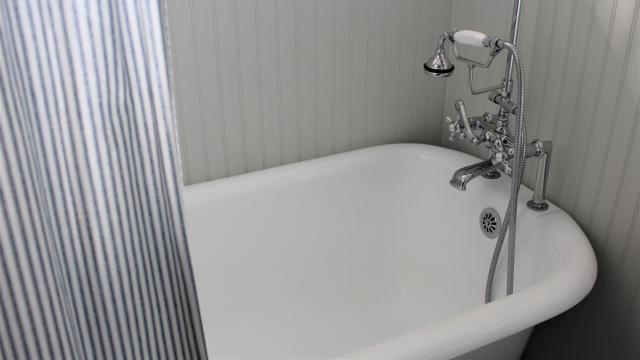An old, stained, scratched, and/or discolored bathtub is an eyesore, and not a pleasant place to put your naked body. But replacing a tub is not just a disruptive process, it’s also damned expensive — the average cost is nearly $8,000, and it can be much higher.
The next-best solution is to refinish the tub, which involves repairing imperfections, thoroughly cleaning the surface, and then re-glazing the tub with a durable coating. Professional tub refinishing can cost up to $US1,000, though, which is still a lot of money. And then you notice that you can buy a DIY tub refinishing kit for as little as $US30 ($42) — or a higher end kits that costs somewhere in the $US150–$US200 range — and DIYing it starts to look like a relative bargain.
Which might be true if the kits worked. But in most cases, the kits don’t work. Here’s why this is one project that might not be worth going it solo.
Tub refinishing is a difficult DIY job
The first thing to understand about DIY bathtub refinishing is that it is a lot more work than you think. Those hundreds of dollars you’re saving are simply transformed into sweat equity. You’ll need to think about proper ventilation, because working with the materials involved in a small room (perhaps with one small window) is a great way to kill yourself, and that also means you’ll need to invest in some safety gear, including a respirator and safety glasses.
You’ll need to repair scratches and other damage, tape off the tub’s surround, clean the tub very thoroughly — then rinse and dry it equally thoroughly. You’ll have to etch and scuff the existing finish, apply a primer, possibly mix the epoxy, and then paint the tub.
The work can be done in one day, though it may take anywhere from one to three days for the new glaze to completely cure. That might not sound so bad, but it is easy to do something wrong and not even know it until days later. If your cleaning isn’t thorough enough, your new finish will fail. If you don’t etch the surface well enough, your new finish will fail. If you mix the epoxy incorrectly (though not all kits require mixing), your finish will fail. Worst of all, even if you do everything right with a DIY kit, your finish will (eventually) fail.
The results of a DIY tub refinishing may not be what you expect
Most successful DIY tub refinish projects last about two years, while a professional refinishing will last 10–15 years. Your own efforts might last much longer — or fail much more quickly. Even if it looks pretty great when you’re finished, normal use will likely soon result in chips and peeling. People have reported that suction-cup mats placed on the bottom of DIY refinished tubs have pulled up the finish, and even minor errors in applying the new glaze can allow water to infiltrate underneath, resulting in bubbling and peeling.
The aesthetic results are another consideration. If you opt to use a brush and roller to apply the new finish (a paint sprayer will give you best results, but those are expensive to purchase or rent, and will require a lot more prep work to protect the other surfaces in your bathroom) there’s a very good chance you will see visible brush marks or inconsistent coverage in the finish. Unless you’re extremely careful, your tub will turn out looking like someone painted it, which is likely not the result you’re seeking.
A final consideration is deferred costs. Even if your refinish project goes smoothly and you realise decent-looking and acceptably durable results, if you opt to have your tub professionally refinished at a later time, the contractor may charge you extra to remove your DIY work first.

Leave a Reply
You must be logged in to post a comment.